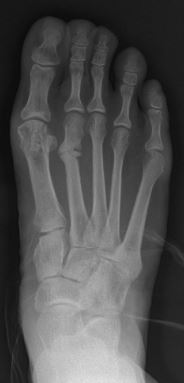
All About Stress Fractures
What is a stress fracture?
A stress fracture occurs when muscles are fatigued and unable to protect bones from the exertion of sports or exercise. This results in tiny cracks in the bone. Bones that are weight-bearing, such as those in the foot and lower leg, are especially at risk for stress fractures.
What causes a stress fracture?
Typically, stress fractures are caused by engaging in activities too intensely or quickly. Other factors include surfaces a player isn’t used to; incorrect equipment (such as worn-out shoes); and playing too long and too vigorously.
What areas of the body are affected by stress fractures?
Predominantly in bones responsible for bearing weight. Those include the lower leg and the foot.
Who’s most likely to get stress fractures?
Athletes who participate in sports that involve a jot of running and jumping, such as track, tennis and basketball are susceptible to stress fractures. The activity of feet frequently striking the ground can cause them. Overuse is also a culprit.
Do women get more stress fractures than men?
It seems so. This is referred to by some orthopedic surgeons and sports medicine professionals as “the female athlete triad,” which is comprised of eating disorders (such as anorexia), an infrequent menstrual cycle and osteoporosis, all of which reduce bone mass and can lead to stress fractures.
How do I know when I have a stress fracture?
Pain! That’s the first signal. Resting the injury is the best thing you can do.
How are stress fractures identified?
X-rays are utilized. Sometimes, they won’t show up on regular X-rays, so a computed topography (CT) scan may be called for.
How are they treated?
Rest, above all. Avoid going back to the activity that caused the stress factor in the first place for six to eight weeks. If you resume the activity too quickly, it can result in larger, harder to heal fractures. Wore, it can become chronic and never heal properly.
How to prevent stress fractures
The American Academy of Orthopaedic Surgeons put together some guidelines.
- When starting a new sports activity, set incremental goals. As an example, if you begin running, build up your mileage on a weekly basis.
- Alternating activities that accomplish the same fitness goals can help to prevent stress fractures. Instead of running every day to meet cardiovascular goals, run on even days and bike on odd days. Also add strength training and flexibility exercises to the mix for the best results.
- Eat a healthy diet. Incorporate calcium and Vitamin D-rich foods in your meals.
- Use the correct equipment. Do not wear old or worn-out running shoes.
- If you suffer from pain or swelling, immediately stop the activity and rest for a few days. If continued pain persists, contact us at (210) 545-7171.
“If you have any concerns, an X-ray and office visit is a great place to start,” says Dr. Alexandra Matthews, Sports Medicine Specialist. “We can also discuss work out routines and safely increasing duration and intensity of exercise to prevent stress fractures.”

 Previous Post
Previous Post Next Post
Next Post




